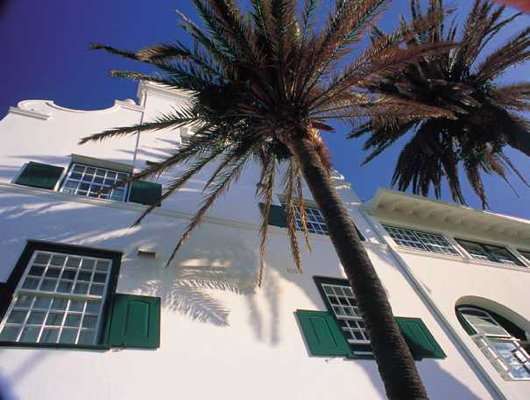Cape Town
About Andrew Cusack
 Writer, web designer, etc.; born in New York; educated in Argentina, Scotland, and South Africa; now based in London.
Writer, web designer, etc.; born in New York; educated in Argentina, Scotland, and South Africa; now based in London. read more
News
Blogs
Reviews & Periodicals
Arts & Design
World
France
Mitteleuropa
Knickerbockers
Argentina
The Levant
Africa
Cape of Good Hope
Netherlands
Scandinavia
Québec
India
Muscovy
Germany
Academica
An African View of the Heavens
Catholic Clerical Skygazers at the Cape of Good Hope
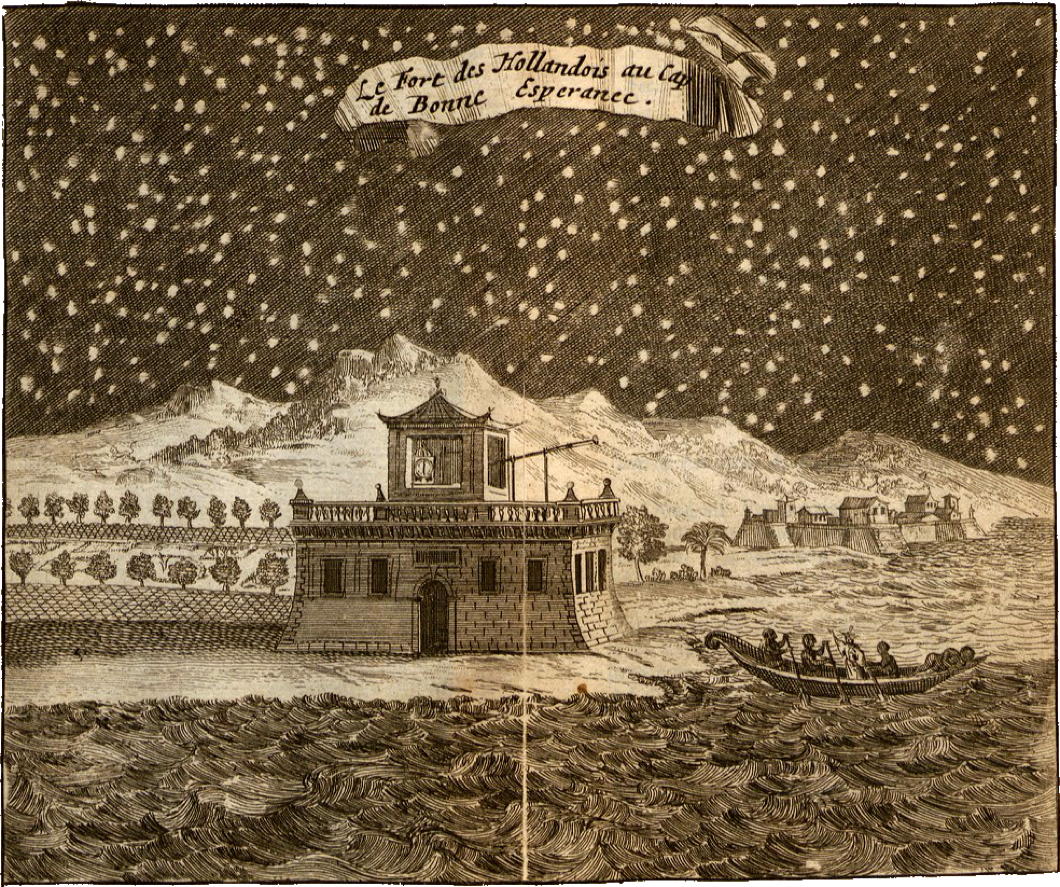
In 1685, the Jesuit mathematician, astronomer, and not-quite-secret-agent Fr Guy Tachard stopped off at the Cape of Good Hope en route to Siam as an emissary of the Sun King, Louis XIV.
Given Dutch hostility both to the French and to Catholicism, Père Tachard was surprised by the generous welcome provided by the governor, Simon van der Stel. Tachard was allowed to set up an astronomical observatory in the Company’s Gardens (today Cape Town’s equivalent of Central Park). No sooner had this happened than the clandestine Catholics of the colony searched the priests out.
“Those who could not express themselves otherwise knelt and kissed our hands,” one of the expedition’s priests wrote. “In the mornings and evenings they came privately to us. There were some of all countries and of all conditions: free, slaves, French, Germans, Portuguese, Spaniards, Flemings, and Indians.”
Those who spoke French, Latin, Spanish, or Portuguese were lucky enough to have their confessions heard but one thing was absolutely forbidden: the Mass. The Dutch authorities would not permit Mass to be offered on land, and local inhabitants were forbidden from visiting the French ships.
Once, while the priests took ashore a microscope covered in beautiful Spanish gilt leather, locals suspected them of trafficking in the Blessed Sacrament such that the clerics were forced to demonstrate the use of the microscope to prove they were heeding the Governor’s instructions.
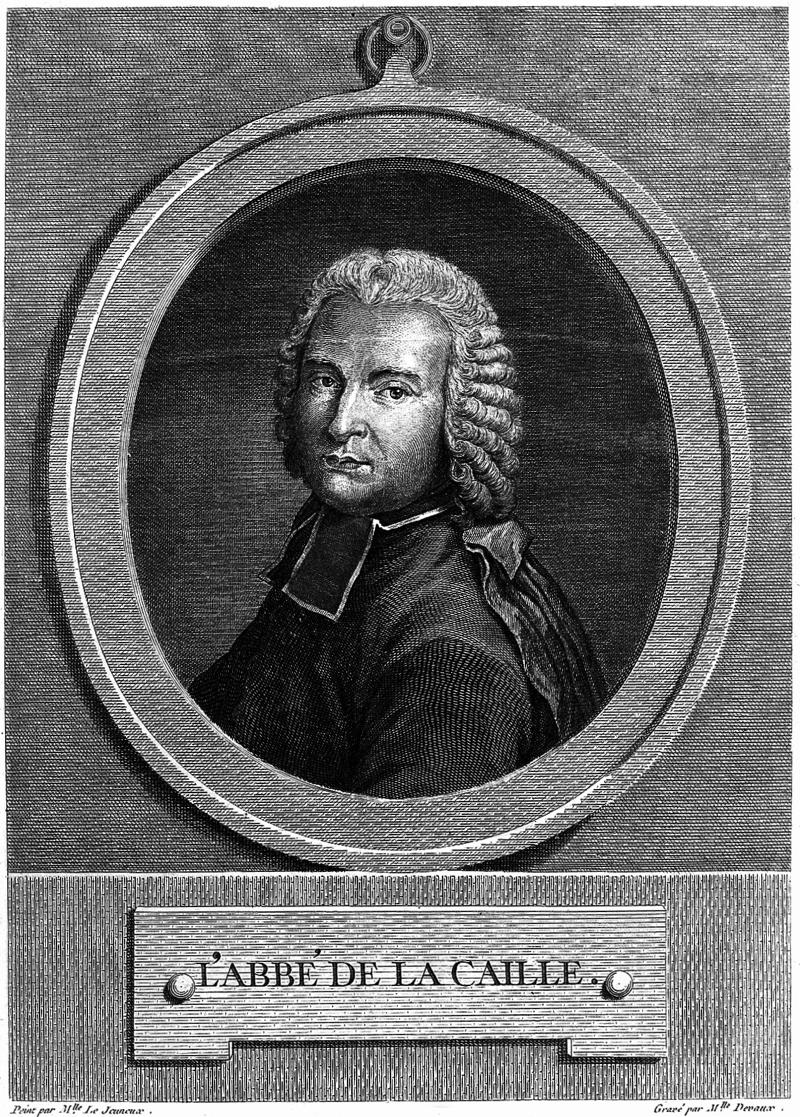 A century later another French cleric-astronomer, the Abbé Nicolas-Louis de Lacaille, made his way to the Cape during Ryk Tulbagh’s time as Governor of the Dutch colony.
A century later another French cleric-astronomer, the Abbé Nicolas-Louis de Lacaille, made his way to the Cape during Ryk Tulbagh’s time as Governor of the Dutch colony.
As a mere deacon Lacaille could not offer the Mass and we know little of his relations with any remaining Catholics at the Cape.
There’s no doubt, however, that his contribution to astronomy while in South Africa was significant: Lacaille’s two years of astronomical observation there were prolific in their results. Of the 88 constellations currently recognised by the International Astronomical Union, fourteen were named by Lacaille — including the constellation Mensa (“table”) which took its name from the Latin for Cape Town’s Table Mountain.
Mensa remains the only constellation named after a feature on Earth, so there is a little bit of South Africa that is visible in the night sky anywhere south of the fifth parallel of the northern hemisphere.
Die Ou Swaai Pomp
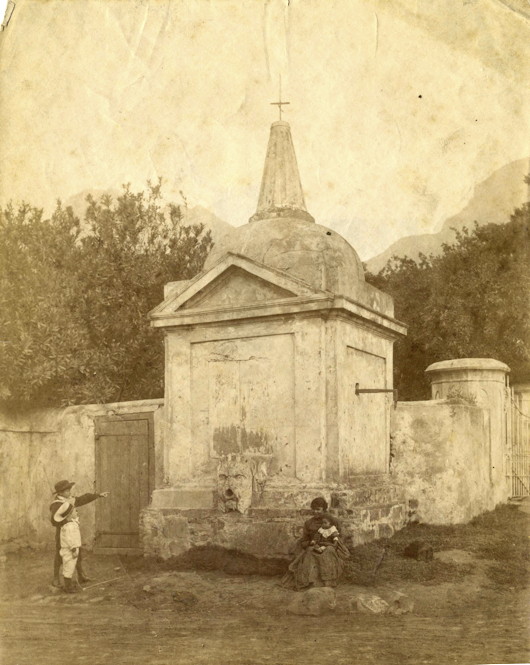
The old water pump at the corner of Prince Street and Sir George Grey Street in the Cape Town neighbourhood of Oranjezicht was part of the system created by the Swede Jan Frederik Hurling in the 1790s for his farm, Zorgfliet. This particular structure was erected at the pump site in 1812 to a design by Louis Michel Thibault, embellished with a water-sprite gargoyle attributed (inevitably) to Anton Anreith.
It was operated by swinging the wooden handle on the side to and fro, hence why it is known as a swaai, or “swinging”, pump.
The photo above is the work of the Cape photographer Arthur Elliott whose work not only documents the early architecture of the Cape but more often than not manages to do so in an artistic and evocative manner.
Elliott is especially valuable considering how many of these structures faced the wrecking ball in the intervening century since he took his photographs, though — as you can see from a Google StreetView capture below — the Old Swaai Pump is still in its place today and is a monument protected by national and provincial law.
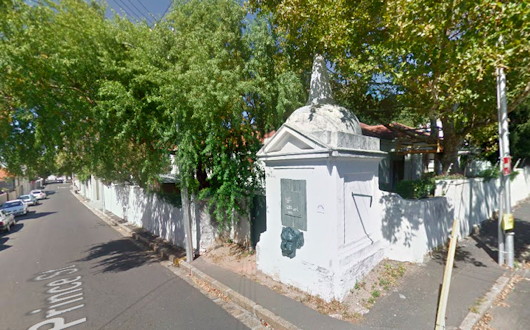
Keeromstraat 14
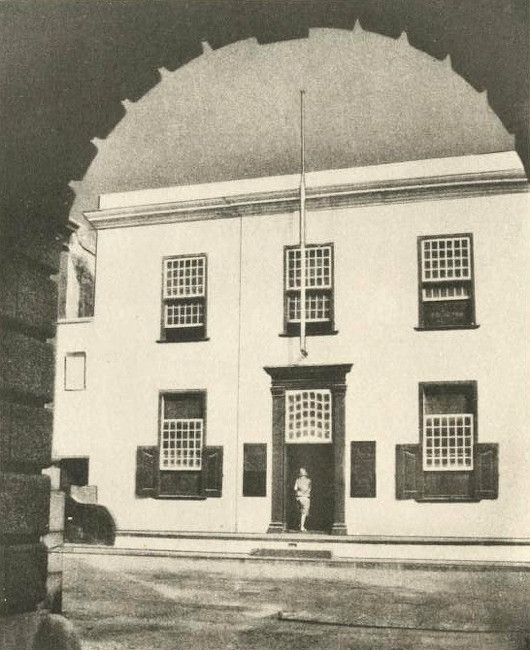
Keeromstraat 14, Kaapstad
This Cape Town house was built in 1751 for Hermanus Smuts who sold it on to Johan Jacobus Graaff, the woodworker who collaborated with South Africa’s greatest architectural duo, the sculptor Anton Anreith and the architect Louis Michel Thibault.
Thibault is believed to be responsible for the addition of the upper story and the current façade, seen above through an archway of the High Court.
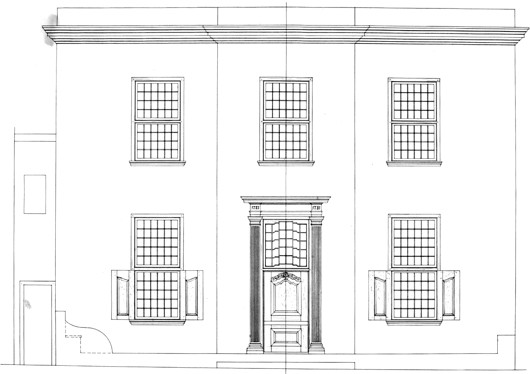
The building next door was designed by the pioneering Afrikaner architect Wynand Hendrik Louw (1883-1967) for De Nederlandsche Club te Kaapstad, the city’s club for Dutch businessmen and expatriates. Louw was also the architect of the Dutch Reformed Church at Napier in the beautiful Overberg.
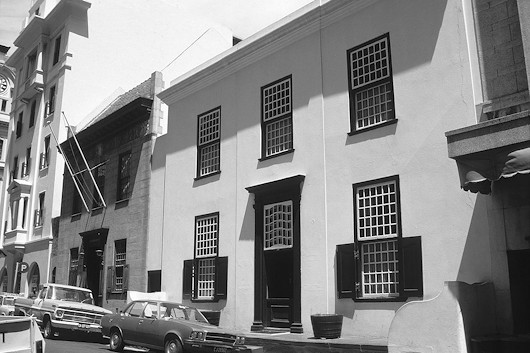
Alles Sal Reg Kom
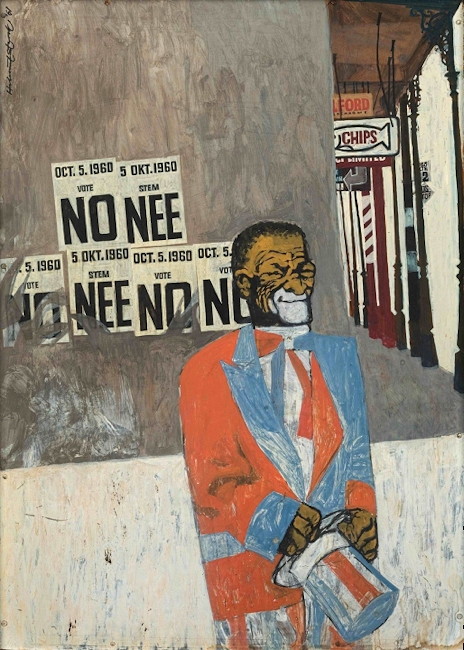
1961; Acrylic on board, 34.8 in. x 24.8 in.
A man festively attired in a Tweede Nuwejaar outfit in patriotic colours (orange, white, and blue) stands in front of a side wall in Cape Town bearing monarchist posters urging voters to vote ‘No’ in the 1960 republic referendum.
The painting’s title – Alles Sal Reg Kom – means “everything will be alright”.
Interior of the Groote Kerk
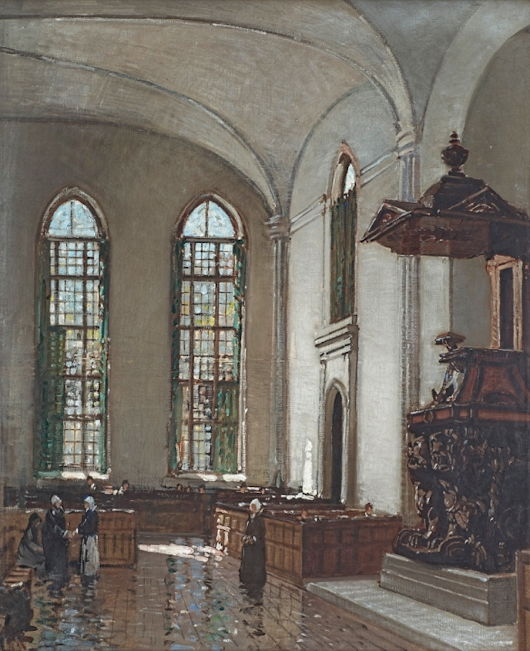
1916; Oil on canvas, 29½ in. x 24½ in.
Though the painting is just a hundred years old, Gwelo Goodman depicted the scene as if in the late seventeenth century — when the Groote Kerk was first built.
While the body of the church was replaced in the 1840s, the elders of this most senior Nederduits Gereformeerde gemeente wisely kept the stunning baroque pulpit, the work of the Cape’s greatest sculptor Anton Anreith.
Overwhelming the Farber Building
A bland glass-plated giant will piggy-back onto a sound example of the Modern Movement in Cape Town
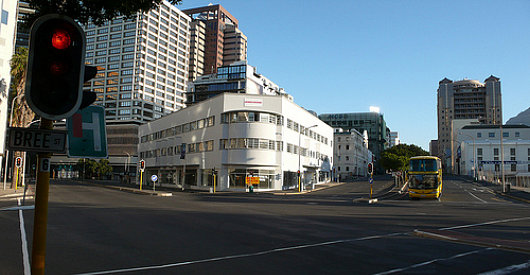
The Farber Building, one of the few extant examples of the Modern movement in architecture in Cape Town, is to be overwhelmed by an eighteen-storey plate-glass skyscraper. The developers had sought to have the 1935 building designed by Roberts & Small demolished, but the city fathers wisely refused permission. The price of its salvation, however, is that the boring skyscraper will piggy-back onto this actually rather inoffensive Modern structure. (more…)
The Major-General’s Statue
Die staanbeeld van Maj-Gen Lukin in die Kompanjiestuin
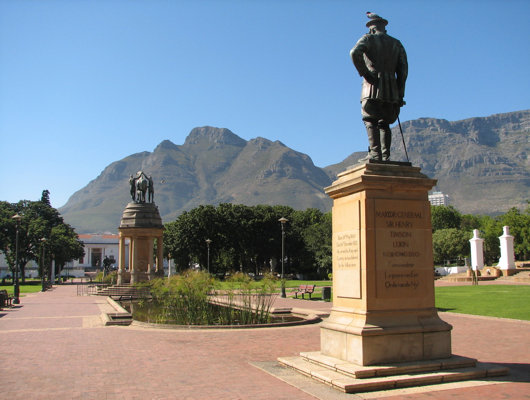
While Afrikaans is a mild obsession of mine, I do like finding those holdouts of what they used to call “High Dutch” — in contrast to the ordinary South African spoken Dutch which, because of its differences in grammar and spelling, was eventually recognised as the language Afrikaans.
One such old Dutch holdout can be found on the statue (Af: staanbeeld; lit.: ‘standing-picture’) of Maj. Gen. Sir Henry Timson Lukin in the Company’s Garden, Cape Town. The pedestal proclaims in a very handsome font the General’s rank, name, and orders. In Dutch: Majoor-Generaal Sir Henry Timson Lukin, KCB CMG DSO, Commandeur Legioen van Eer, Orde van de Nyl.
Most of this works perfectly well as Afrikaans but for two slight differences. First: The lack of ‘i’ in de always indicates Dutch rather than Afrikaans, but because of the relative youth of Afrikaans, de can sometimes be employed as an antiquating device. For example, when translating the name of Captain Haddock’s ship in the Afrikaans translation of the Tintin book, the translators chose De Eenhorn (the Unicorn) rather than Die Eenhorn. Obviously an old-fashioned sailing ship would belong to a Dutch-speaking era rather than an Afrikaans-speaking one.
Second is the military rank. Here translated as majoor-generaal, in both Dutch and Afrikaans this evolved into generaal-majoor. Just one of those things. The South African Defence Forces has a history of experimental military ranks which did not last: Commandant-General (for General), Combat General (for Major General), Colonel-Commandant (for Brigadier), Commandant (for Lieut. Colonel), and Field Cornet (for Lieutenant).
There’s your random bit of Afrikaans arcana for the day.
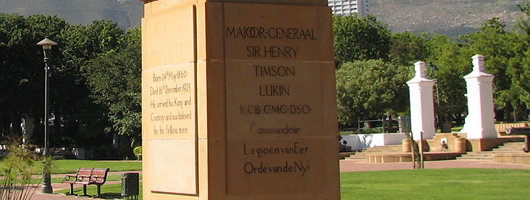
Cape Town’s ‘Nazi’ Street to be Renamed
Oswald Pirow Street will rechristened after Dr. Christiaan Barnard
The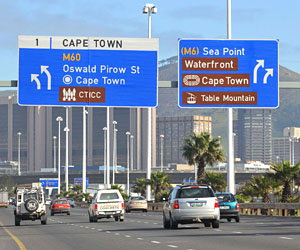 city of Cape Town has recently effected a small number of street name changes decided at the end of last year. The N2 route as it heads into the centre of the city, currently called Eastern Boulevard, will be renamed Nelson Mandela Boulevard. The open square between the opera house and the city offices will be renamed Albert Luthuli Place. Most significantly, Oswald Pirow Street on the Cape Town foreshore will be renamed Christiaan Barnard Street.
city of Cape Town has recently effected a small number of street name changes decided at the end of last year. The N2 route as it heads into the centre of the city, currently called Eastern Boulevard, will be renamed Nelson Mandela Boulevard. The open square between the opera house and the city offices will be renamed Albert Luthuli Place. Most significantly, Oswald Pirow Street on the Cape Town foreshore will be renamed Christiaan Barnard Street.
The renaming of streets and other places in South Africa has proved a controversial and unsettling task. Many streets named after leading figures associated with the 1948-1990 apartheid regime remain. In 2001, the New National Party (NNP) mayor of Cape Town, Peter Marais, attempted to rename Adderley Street and Wale Street after Nelson Mandela and F.W. de Klerk respectively. But Marais’s plan provoked a surprising public backlash, as well as opposition-for-opposition’s sake from the local ANC. The proposed ‘Nelson Mandela Avenue’ had already been renamed once: originally Heerengracht, the grateful citizens of Cape Town rechristened it Adderley Street in 1850, as a token of thanks to Charles Bowyer Adderley MP (later 1st Baron Norton) for his successful campaign against turning the Cape into a penal colony. (more…)
Salazar-plein / Salazar Square
Cape Town’s monument to a Portuguese friend of South Africa
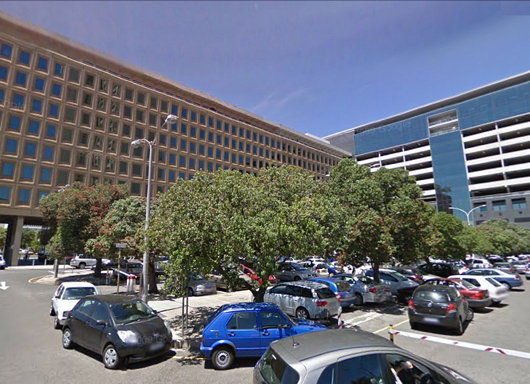
Doubtless there were once many streets, squares, and places named after António de Oliveira Salazar, Portugal’s longtime dictator — the Ponte Salazar being the one that springs immediately to mind. That bridge, like most other Salazarian toponyms in the Lusosphere, was renamed after Portugal’s Carnation Revolution, even though the dictator remains a reasonably popular figure (a poll for the RTP television programme The Greatest Portuguese he came out top with twice as many votes as the runner-up). (more…)
Winchester Mansions
STARING ACROSS Sea Point Promenade towards the waters of the Atlantic in Cape Town, there sits Winchester Mansions. The hotel was built in 1922 in a style emblematic of the period’s revival of interest in the Dutch colonial age at the Cape. People often associate the 1920s with Art Deco, but the style was only just emerging in Paris at the time, and wasn’t even called ‘Art Deco’ until the 1960s. The ‘mother city’ has its fair share of Art-Deco and Moderne buildings, but architectural trends took a while to arrive in South Africa — though they tended to last longer then elsewhere. The Cape Dutch Revival emerged in the 1890s and perhaps reached its high-water mark in the 1900s and 1910s. Curiously, it is not associated with the simultaneous emergence of Afrikaans as a language and the rising consciousness of Afrikaner identity, but rather with a very Anglo and colonialist mindset. It was Dorothea Fairbridge and Milner’s ‘Kindergarten’ — respectively the social and political forces seeking to unite all of South Africa under the British crown — that promoted the adoption of the Cape Dutch as a national style. Thus the years leading up to Union in 1910 and its initial decade or two were the heyday of the Cape Dutch Revival as it was the favoured boustyl for the respectable Cape- and Rand-based imperialists.
The City of Unexpected Charm
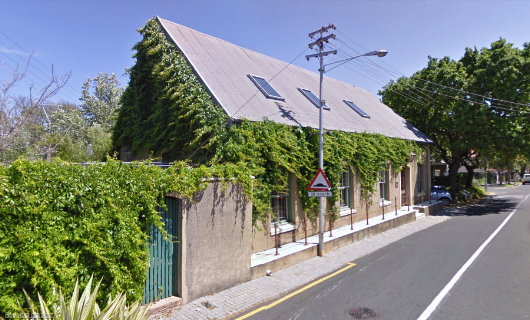
One of the things I like about Cape Town is its continual ability to surprise by throwing up surprisingly handsome buildings in unexpected places. To be honest, there is a great deal of mediocre architecture in the city, though I’d argue Cape Town’s mediocre architecture is better and more humane than, say, New York’s or London’s. But if you keep your eyes open to the world around you as you potter about the Cape, you can stumble across some happy little structures. This little building in Rondebosch is one such example. It sits on Rouwkoop Road, the street which takes its name from the old house that is no more. The N.G. Kerk Rondebosch is just down St Andrews Road one way, and St. Michael’s Catholic Church is just down Rouwkoop Road the other way. (more…)
Murder in Gugulethu
IT’S ONE OF those things where you just think to yourself: “Why? Why on earth did they do it?” Why on earth would a tourist couple finish a lovely dinner in smart Somerset West and think “Oh, I know, let’s head to a poverty-ridden township alone in the middle of the night”. Apparently some ninny of a television chef recommended a place in Gugulethu as a hip-happening nightspot. Sometimes you’re just astounded. And why didn’t the driver say no? Wasn’t he a local? Shouldn’t he have just refused?
Supposedly the poor victim was moved by a desire to see “the real Africa”. As Seraphic points out, I was in South Africa for most of last year and I didn’t go wandering around looking for “the real Africa”. The reason is because it was all around me. The vineyards, the oak-lined streets, the white-washed houses, and the mouth-watering restaurants — this is real Africa. The culture of the Cape has been around for four-hundred years; how long before it’s considered “real”?
Those who feel disappointed if they don’t see the depraved horrors of poverty are peddling a false stereotype that if it isn’t poor, black, and filthy, it isn’t African. (more…)
The Lion’s Gate
VISITORS TO CAPE TOWN may be surprised that, given the beauty and multiplicity of animals in the vicinity, the ‘Mother City’ has no zoo. There is actually a popular zoo at Tygerberg, twenty-four miles from Cape Town and less than ten miles from Stellenbosch, which is the only zoo in the province. But centuries ago — around 1700 — a ‘menagerie’ was founded in the Company’s Gardens in Cape Town which survived for over a hundred years.
François Valentijn, in his visit of 1714, noted the menagerie boasted a pair of ‘rheen’ or ‘rheebokken’ (probably kudu), a black rhinoceros, an eland, a ‘rossen bok’ (possibly a hartebeest), a hippopotamus, two lions, and a zebra. In the 1770s, the Swede Anders Sparrman noted the presence of many springbok, a warthog, some ostriches, and even a cassowary. The selection varied widely through the years, and given Cape Town’s status as ‘The Tavern of the Seas’ central to the European route to the Indies and the Far East, the zoo included not only African beasts but also some (like the Papuan cassowary) brought from the Orient.
In 1777, the notorious rake William Hickey ventured to extoll it as “the finest menagerie in the world, in which are collected the most extraordinary animals and birds of every quarter of the globe”. Less than fifteen years later, however, Lt. George Tobin of the Royal Navy described it as “a menagerie of some extent. It was but poorly supplied, there being but a few ostriches and some different kinds of deer.” Decades later, in February 1825, a traveller noted the menagerie in the pages of the Montly Magazine of London:
At the end of the Grand Walk, which is nearly three-quarters of a mile long, is the Company’s Menagerie, which is worth seeing, on account of a good-natured old lion, supposed to be the largest ever taken into captivity, and a tiger of immense size and power; there are several other specimens of African animals: but those are infinitely the largest of their species I ever saw—we have nothing that comes near them in England.
A spiritually inclined passer-through, the Rev. Henry Martyn, Chaplain to the Honourable East India Company, stated in 1832 that the “lion and a lioness, amongst the beasts, and the ostrich, led my thoughts very strongly to admire and glorify the power of the great Creator.” It was around that time that Sir Benjamin d’Urban, Governor of the Cape, granted land next to the menagerie for the erection of a building for the South African College, the germ of what would become the University of Cape Town. This was the beginning of what is now called the Hiddingh campus of UCT, the institution’s first home which continues alongside the main campus built on the Rhodes estate on the slopes of Devil’s Peak. The menagerie was shut in 1838 and the first building of the proto-UCT went up the next year in an exotic Egyptian Revival style.
The lion gates, however, are from earlier. They were built in 1805, probably by Thibault, with the lions & lionesses sculpted by the architect’s frequent collaborator Anton Anreith, also responsible for the magnificent pulpit in the Groote Kerk. The lionesses on the UCT side are original but the lions on the other side, curiously, were removed in 1873. In 1958 they were restored when Ivan Mitford-Barberton — arguably South Africa’s greatest sculptor after Anreith — created new beasts for the old perches. The gates are still there if you walk up the Government Avenue that bisects the Company’s Gardens, beautiful in the eye of this beholder in their immaculate, white, classical elegance.
Unbuilt Cape Town: Municipal Offices
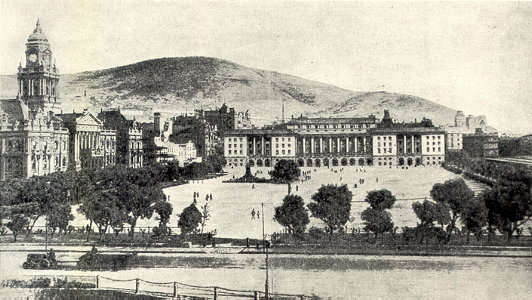
UNBUILT ARCHITECTURAL PROPOSALS fascinate me. Unfortunately most of the books documenting the more prominent examples of unbuilt buildings focus on space-age hyper-modernist ideas that never got off the drawing board, but these tend towards the tawdry and ridiculous. Far more interesting are the rejected proposals for buildings that did get built — for example the rival schemes to rebuild the Palace of Westminster after the 1834 fire — or this example of a proposal for a building never executed. I came upon these scheme thanks to the uploads of the Flickr user Berylmd. While Cape Town has a splendidly grand City Hall in an Edwardian Baroque style, the city fathers were unwise in providing insufficient space for the ever-blossoming municipal bureaucracy. This plan would have put a new municipal office building spanning the entire western side of the Grand Parade, replacing those little unremarkable market buildings whose existence on the square persists to this day. (more…)
Googlebosch
Google Street View Comes to the Eikestad and all South Africa
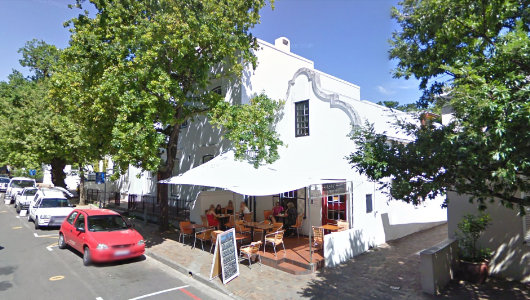
There had been rumours for a while. Talk had spread around the land of strangely equipped vehicles criss-crossing the country, and now the whole world can access Google Street View for South Africa. Naturally, they haven’t managed to capture every street in the whole country, but Cape Town, the Peninsula, and the Boland are well-covered, which naturally includes the handsome town of Stellenbosch that I used to call home. This of course provoked a mini-tour of the Eikestad and environs to see all the old familiar places. Above is Basic Bistro, the finest establishment in town, where one would oft find me planted outside with a pot of rooibos and the day’s edition of the Cape Times or Die Burger. The little alleyway to the right led to the back entrance to my old place. (more…)
The Versatility of the Cape Dutch Style
ORANJEZICHT IS ONE of my favourite parts of Cape Town, nestled in the bowl between Table Mountain and Signal Hill. Its name betrays it’s sloping location, which offers a view towards the Oranje bastion, one of the five of the Castle, which take their name from the titles of William, the Stadthouder of the United Provinces. The architecture is generally handsome, even if it often tends towards the Victorian. A few years ago, Cape Town Daily Photo featured a view (above) of the corner of Montrose Avenue and Bo-Oranjestraat in Oranjezicht. The late-autumn/early-winter street scene focusses on the Oranjezicht Carlucci’s, one of a small chain of delicatessens and wine shops founded in the mid-1990s.
The architecture of the shop is by no means in the strictest confines of the Cape Dutch style but is instead a more modern design influenced by the local architectural tradition of the Cape. While the Cape tradition is better known for larger country houses and wine-growing estates or small cottages, it’s just as useful a guide in the urban context. Dating the age of the building just by this photo would be tricky, as the region has some fairly convincing recent structures built in the old style (the dovecot at Alphen, for example), but I’d wager it’s 1900s-1910s construction that underwent a substantial renovation in the 1990s. (more…)
Cape Town’s Other St. George’s
The Greek Orthodox Cathedral of Saint George
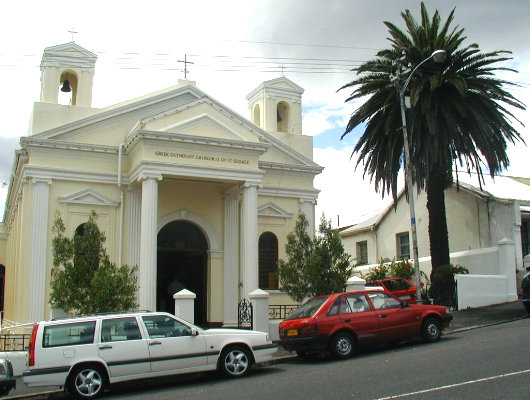
If you hear of “St. George’s Cathedral” in Cape Town, you naturally think of the big stone colossus at the bottom end of the Company’s Garden smack dab in the middle of the Mother City. There is, however, another St. George’s Cathedral, the Greek Orthodox Cathedral of St. George on Mountain Road in Woodstock. The Greek Cathedral was built in 1903–04, just a few years after Cape Town received its first Greek Orthodox priest, and expanded in 1983. Liturgies tend to be either in Greek or English, though there is an Afrikaans monastery at Robertson.
The Holy Archdiocese of the Cape of Good Hope was established in 1968 under the (Greek Orthodox) Patriarch of Alexandria and All Africa. The archdiocese covers the Western, Northern, and Eastern Cape provinces, the Orange Free State, KwaZulu-Natal, Namibia, Lesotho, and Swaziland.
I only ever knew one South African of Greek extraction (Dimitri! Not just a good egg, but a top-notch chef as well), but I assume that folks of Hellenic extraction enjoy the Mediterranean climate of Cape Town and its environs.
Cape Town’s New Way to Get Around

Over at Fascination Street, Brent Smith shows us the newly revealed branding for Cape Town’s new integrated rapid transit system: MyCiti. I’m not partlicularly impressed. Most of my fellow uitlanders will be forgiven for lacking an understanding of the stylised freehand letter ‘y’, which is rather tortured into representing an outline of Devil’s Peak, Tafelberg, and Lion’s Head. Mr. Smith diplomatically reserves judgement but I think they could’ve done better, although they could have done much worse.
The State Opening of Parliament
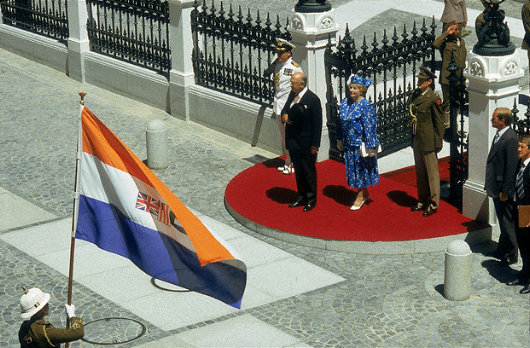
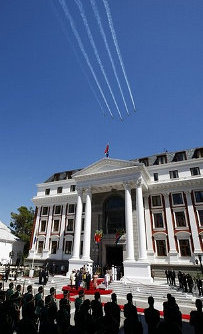 The State Opening of Parliament has always been an occasion of great ceremony, most especially so on the one occasion when the King of South Africa himself was actually present. When South Africa became a republic in 1961, the State President took the role of the Governor-General. While formerly centered on the old main entrance, the President now enters Parliament at the 1983 wing (as seen at right), where he is greeted by a guard of honour and pauses to hear the National Anthem played by a military band.
The State Opening of Parliament has always been an occasion of great ceremony, most especially so on the one occasion when the King of South Africa himself was actually present. When South Africa became a republic in 1961, the State President took the role of the Governor-General. While formerly centered on the old main entrance, the President now enters Parliament at the 1983 wing (as seen at right), where he is greeted by a guard of honour and pauses to hear the National Anthem played by a military band.
Before 1994, morning dress was the norm for the State President (and for the Governor-General before him), but since that time the head of state has tended to wear a business suit on the occasion. That doesn’t stop the other Members of Parliament and their spouses from dressing up. There’s an unspoken contest among female MPs and MPs’ wives to wear the most daring or arresting hat to the State Opening, and often tribal leaders attend in the traditional dress of their peoples. (more…)
The National Assembly
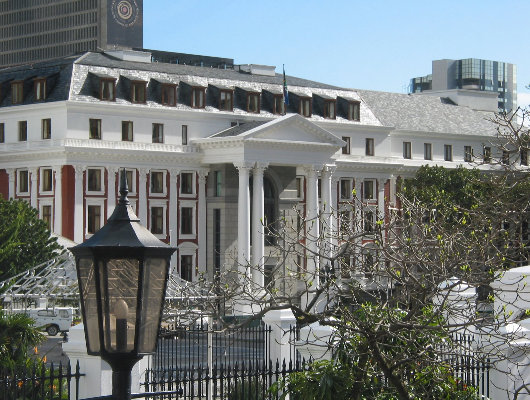
Despite the longer history behind the original wing of South Africa’s Parliament House, when most people think of Parliament today they think of the 1983 wing that currently houses the National Assembly. The wing was designed by the architects Jack van der Lecq and Hannes Meiring in a Cape neo-classical style similar to the rest of the building, and it is actually quite a handsome composition despite the awkwardly proportioned portico, which is too tall for its width or two narrow for its height. (more…)
Search
Instagram: @andcusack
Click here for my Instagram photos.Most Recent Posts
- Burns Tower April 19, 2024
- Patrick in Parliament March 18, 2024
- Articles of Note: 13 March 2024 March 13, 2024
- Cambridge March 9, 2024
- Taken on Trust March 4, 2024
Most Recent Comments
Book Wishlist
Monthly Archives
Categories

